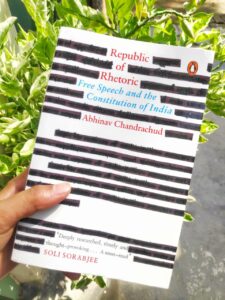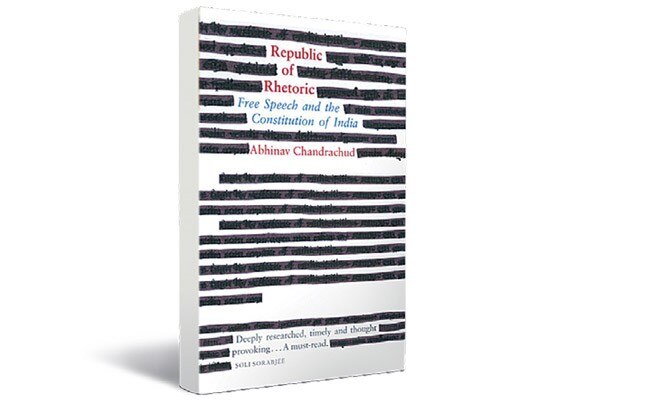When Rousseau was talking about binding force of chain, he would have probably in mind the right of freedom and expression too. The freedom of speech and expression is a human right; it is not ‘gifted’ by the state to its citizens but it is given to them because it is fundamental to the full realization of one’s potential and is their right as a human being.
In India, the journey of freedom of speech and expression was somewhat like of roller-costar ride, there were times when it was revered and many times it was brutally curtailed and people were put to prisons when they crossed the Laxman Rekha drew by government. At present time, when freedom of speech is facing deep blow, talking about freedom of speech becomes relevant.
The book ‘Republic of Rhetoric-Free speech and the Constitution of India’, written by Abhinav Chandrachud, was released in 2017. It is a documentation of legal and political history of freedom of speech and expression in India with the reference from America and Britain. From the inclusion of Article 19 in the constitution and its history of inclusion, to the history of prior restraint to newspapers, origin of sedition, obscenity and hate speech provisions in the IPC, and finally the rule of sub-judice and contempt of court, the book touches every aspect of freedom of speech.

The main theme which author tries to set in the beginning of the book is that the restraint and trend to curb and curtail freedom of speech and expression has not been changed even after the arrival of constitution in India which is called the protector of citizens’ human right including freedom of speech which is an important part of human rights. However, with the flow of the book, the author himself mention judgments of court, decisions of government and situations when it seems that freedom of speech is getting strength, but, not forget to mention the cases when freedom of speech faced blow through the decision of government and court.
Writing about the rule of sub-judice, the author criticizes that supreme court of India still subscribe to the colonial notion that stories which appear in print in India, and which lower the authority of a judge, are more likely to be believed here because many Indians are ignorant, as against Englishmen who may be skeptical when they read such stories.
The author further mentions in detail about an interesting incident which took place in 1959 and about which supreme court judges’ historian George H. Godbois jr. called ‘the example of vintage ethics’ when prime minister Nehru nearly committed contempt of court by informing journalists at a press conference that he thought justice Vivian Bose was ‘lacking in intelligence’. However, when he got the information that bar council of Calcutta was furious on this statement and he said something big which he should not have said, he wrote a letter immediately to Bose and CJI asking for apology. There was a correspondence between Bose and Nehru where Bose appreciated Nehru and accepted his apology.
Such a short statement by Nehru was enough to create furore in 1959, but later, we have seen how supreme court in many cases ignored such contempt by saying that the court’s shoulders are broad enough to shrug off their comments.
Such type of changes also came in the cases of obscenity and depiction of crime on the cinema screen. The book contains an another amusing incident when censor board asked the makers of Hindi classic ‘Sholay’ to change the end because the depiction of police personal killing a criminal will give wrong message to people. The book also mentions the well-known cases of ‘Bandit Queen’ and ‘Satyam Shivam Sundram’ movies which were before the court to examine whether they contain obscenity? It is no need to mention that at present time, how the definition of obscenity has changed through the time and only in excessive case like Ekta kapoor’s ‘XXX’, the court says why you polluting the minds of young people.
It must be appreciated that the author labored to put a researched and structured history of IPC and Constitution’s provisions and it is engaging. This is the skill of Chandrachud, which I have also seen in his previous book ‘Supreme whispers’ that he writes the book in storytelling and simple way and it does not feel like we are reading some kind of dry content. However, I should mention that this book mainly focuses on legal history, So, to the people who does not belong to legal field and do not understand legal terminology, the flow of the book may not be maintained.
Above all, this book is highly recommended for the people who are enthusiastic to read the legal and political history of freedom of speech and expression in colonial Indian and under the constitution and add a deep understanding to your mind about the history of sedition, hate speech and pressure on news agencies, which is too relevant at present time.
The Article is authored by Advocate A.H. Gangohi.
